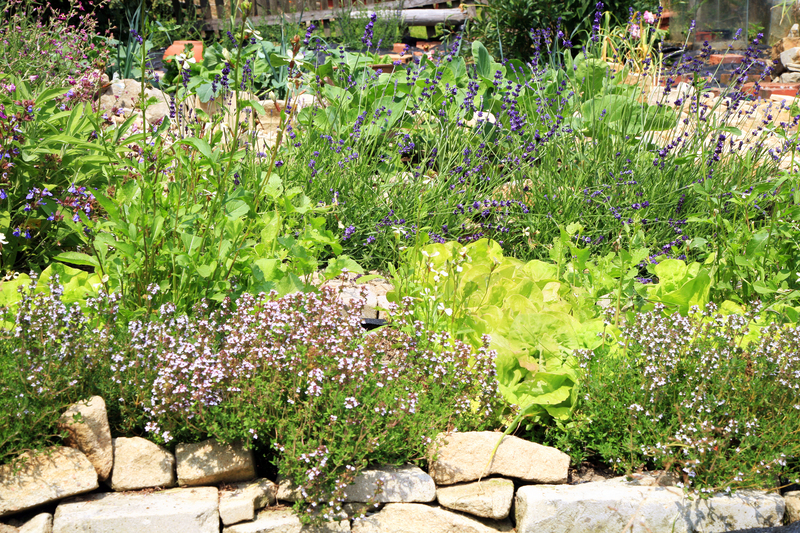Transforming Balconies with Vertical Gardening
Posted on 29/09/2025
Transforming Balconies with Vertical Gardening: A Comprehensive Guide
Urban living often means sacrificing green spaces in favor of convenience and efficiency. However, with the advent of vertical gardening, individuals residing in apartments and high-rise buildings can now create vibrant, lush sanctuaries even in the smallest of spaces. This article explores how to transform balconies with vertical gardens, offering practical tips, creative ideas, and expert recommendations to help you cultivate your very own green oasis.

What is Vertical Gardening?
At its core, vertical gardening is a technique where plants are grown upwards using vertical surfaces rather than traditional horizontal spaces. This could involve using walls, trellises, shelves, or purpose-built structures. With this approach, balconies can be beautifully transformed into productive and aesthetically pleasing spaces, perfect for both novice and seasoned gardeners.
Benefits of Vertical Gardening on Balconies
- Space Optimization: Make the most of your limited balcony space by stacking plants vertically.
- Improved Air Quality: Plants help filter pollutants, providing cleaner air for your home.
- Enhanced Aesthetics: Vertical gardens add texture, color, and a sense of tranquility to urban living spaces.
- Urban Agriculture: Grow your own herbs, vegetables, and fruits, reducing grocery bills and eating healthier.
- Privacy and Shade: Dense vertical gardens can act as green screens, offering privacy and shielding from harsh sunlight.
- Thermal Insulation: Plants can help regulate temperature, keeping your balcony cooler in summer and warmer in winter.
Planning Your Balcony Vertical Garden
Before you start, it's important to plan your vertical garden for optimal results. Here are the key considerations:
1. Assessing Your Balcony
- Sunlight Exposure - Monitor how much direct and indirect sunlight hits your balcony throughout the day. Select plants that thrive in those conditions.
- Wind and Rain - Balconies can be exposed to wind and rain. Consider wind-breakers or select sturdy plants suitable for breezy environments.
- Weight Tolerance - Balconies have weight limits. Use lightweight containers and soil mixes for your vertical garden structures.
- Space Layout - Measure available height and width, and plan how you will arrange your vertical planters, shelves, or trellises.
2. Choosing the Right Plants
When transforming balconies with vertical gardening, plant choice is crucial. Some plants naturally thrive in confined, vertical setups:
- Herbs - Basil, mint, cilantro, parsley, thyme, and oregano grow well in small pots and vertical planters.
- Leafy Greens - Lettuce, spinach, arugula, kale, and chard are excellent for vertical walls.
- Vegetables & Fruits - Strawberries, cherry tomatoes, peas, and peppers can be trained to grow vertically.
- Ornamental Plants - Ferns, succulents, ivy, pothos, orchids, and flowering vines add beauty and lushness.
3. Selecting Vertical Gardening Systems
The market is full of innovative vertical gardening solutions for balconies. Here are the most popular types:
- Wall-mounted panels: Modular systems where pockets or panels are attached to a wall and filled with plants.
- Hanging planters: Pots or baskets suspended from railings, ceilings, or specially designed stands.
- Stackable planters: Vertically stacked containers that allow multiple growing layers.
- Pallet gardens: Recycled wooden pallets filled with soil and plants, propped vertically against a wall.
- DIY trellises and shelves: Custom frames for climbing or trailing plants, or multi-layered shelves for potted specimens.
Step-by-Step: How to Build a Vertical Garden on Your Balcony
-
Design Your Layout
Sketch your balcony and decide where each element--vertical wall panels, trellises, hanging baskets--will go. Think about accessibility for watering and harvesting. -
Choose and Prepare Your Containers
Use planters made of lightweight, durable materials (like plastic or fiberglass). Ensure they have sufficient drainage and are compatible with your chosen vertical system. -
Install Vertical Structures
Securely attach panels, shelves, or trellises to balcony walls or rails. Double check weight limits and safety, especially if drilling or hanging large elements. -
Fill with High-Quality Growing Medium
Use a rich, lightweight potting mix. For edibles, choose organic soil to minimize chemical residues. -
Arrange and Plant
Place sun-loving plants at the top for maximum light, shade-tolerant ones beneath. Group plants with similar water and sunlight needs together. -
Water and Maintain
Vertical gardens dry out quicker than ground gardens. Water regularly and provide liquid feed as needed. Prune, deadhead, and harvest to promote healthy growth.
Creative Vertical Gardening Ideas for Balconies
1. Living Wall Art
Turn your outdoor space into a living artwork with a mix of colorful flowers, foliage, and even succulents arranged in patterns. Framed living wall panels are available commercially or can be crafted at home, offering an instant visual upgrade to any balcony.
2. Edible Vertical Gardens
Why not combine beauty with utility? Plant herbs, greens, and compact vegetables in a vertical system. Harvest them for cooking, enjoying fresh produce steps from your kitchen.
3. Hanging Herb Gardens
Suspend rows of herb pots from railings or overhead brackets. Label each pot for easy identification and snip fresh herbs with ease.
4. Upcycled Pallet Gardens
Reclaim old wooden pallets, fit with landscape fabric, and fill each slat with soil and resilient plants. Pallet gardens are perfect for renter-friendly transformations because they usually require no drilling into walls.
5. Pocket Shoe Organizer Planters
Repurpose a fabric shoe organizer by filling each pocket with soil and planting drought-tolerant flowers or herbs. Hang the organizer on a wall or railing for a quirky, functional green feature.
6. Miniature Vertical Forests
Layer different types of shade-loving plants--including mosses, ferns, and orchids--to create a dense, mini-forest effect in a shaded corner of your balcony.
Maintenance Tips for Balcony Vertical Gardens
Vertical gardens, though space-efficient, require consistent care to thrive:
- Watering: Vertical planters can dry out quickly. Drip irrigation or self-watering systems help maintain moisture levels without daily attention.
- Fertilizing: Regularly feed with diluted liquid fertilizers. For edible gardens, stick to organic options.
- Pest Management: Check leaves for pests or disease. Use natural pest deterrents whenever possible.
- Pruning and Harvesting: Regularly remove dead leaves and harvest herbs and vegetables to encourage further growth.
- Seasonal Changes: Rotate plants by season and bring delicate varieties indoors during extreme weather.
Overcoming Common Challenges in Balcony Vertical Gardening
- Limited Sunlight - Use reflective surfaces or light-colored walls to increase available light. Choose shade-tolerant species for north-facing balconies.
- Wind Exposure - Install windbreak mesh or select tough, flexible plants like grasses and succulents.
- Poor Drainage - Always use containers with adequate drainage holes and elevate planters to prevent waterlogging.
- City Pollution - Leafy plants like ivy can help trap dust and particulates. Rinse leaves regularly to keep them healthy.
Essential Tools and Accessories for Balcony Vertical Gardens
- Hand tools: Trowel, pruners, gloves, and a small watering can.
- Drip irrigation kit: For effortless, regular watering.
- Hanging hooks and brackets: Securely mount planters and accessories.
- Pots and planters: Prefer lightweight, durable materials for ease of movement and maintenance.
- Fertilizers and soil amendments: Choose based on your crop--flowers, edibles, or ornamentals.
- Plant supports: For vines, climbers, and tall-stemmed plants.
Sustainability and Eco-Benefits of Vertical Balcony Gardens
Incorporating vertical gardens into your balcony not only enhances your living space but also supports environmental sustainability:
- Reduces Urban Heat Island Effect: Plants cool and shade surfaces, mitigating summer urban temperature spikes.
- Improves Air Quality: Greenery absorbs carbon dioxide and airborne pollutants.
- Promotes Biodiversity: Vertical gardens offer habitats for pollinators like bees and butterflies, even in city centers.
- Reduces Food Miles: Growing your own herbs and veggies means less reliance on trucked-in produce.
- Encourages Water Conservation: Vertical systems often use less water than traditional gardens, especially with drip irrigation.
Expert Tips for Transforming Balconies with Vertical Gardening
- Start Small, Scale Up - Begin with a handful of easy-care plants and a simple system. Expand as you gain experience and confidence.
- Mix and Match - Combine edible and ornamental plants for beauty and productivity.
- Rotate Crops - Keeps your garden looking fresh and maximizes balcony yield.
- Stay Inspired - Follow vertical gardening blogs and social media for ongoing ideas and advice.
- Engage Neighbors - Inspire building mates to adopt vertical gardening, beautifying the whole complex.

Inspiring Balcony Vertical Garden Designs
Urban gardeners are finding creative ways to use vertical gardens to transform balconies:
- Zen Retreats: Bamboo trellises, water features, and moss walls create peaceful escapes.
- Color Cascades: Brightly blooming petunias, fuchsias, and begonias overflow from hanging baskets for a striking effect.
- Culinary Corners: A wall of aromatic herbs, cherry tomatoes, and strawberries brings the kitchen outdoors.
- Succulent Showcases: Drought-tolerant succulents set in geometrical wall planters for modern style.
- Butterfly Havens: Vertical flowers attract butterflies and pollinators, supporting urban biodiversity.
Final Thoughts: Why You Should Transform Your Balcony with Vertical Gardening
Transforming balconies with vertical gardening is more than just a passing trend--it's a sustainable, empowering, and rewarding practice that enhances your quality of life. Whether you're looking for a fragrant kitchen garden, a lush herbal haven, or simply a beautiful relaxation spot, vertical gardening on balconies is your green solution.
Start planning your balcony transformation today--with a mix of imagination, the right plants, and a little care, your small city space can become a thriving vertical garden paradise.
Frequently Asked Questions
- Can I grow vegetables on a small balcony?
Many vegetables, especially compact or dwarf varieties, are perfect for vertical gardening on balconies. - What are the easiest plants for vertical balcony gardens?
Herbs, leafy greens, succulents, and certain flowering annuals are beginner-friendly and resilient. - How do I water vertical gardens efficiently?
Drip irrigation systems, self-watering pots, and regular monitoring prevent under- or over-watering issues. - Do balcony vertical gardens attract pests?
Good maintenance and diversity of plant species help limit pest problems, and natural remedies are usually effective. - Can renters install vertical gardens on balconies?
Freestanding or hanging systems can usually be set up without permanent fixtures--always check with landlords first.
Embrace the beauty, functionality, and eco-benefits of vertical gardening to transform your balcony into a personal green oasis--one vertical planter at a time!

